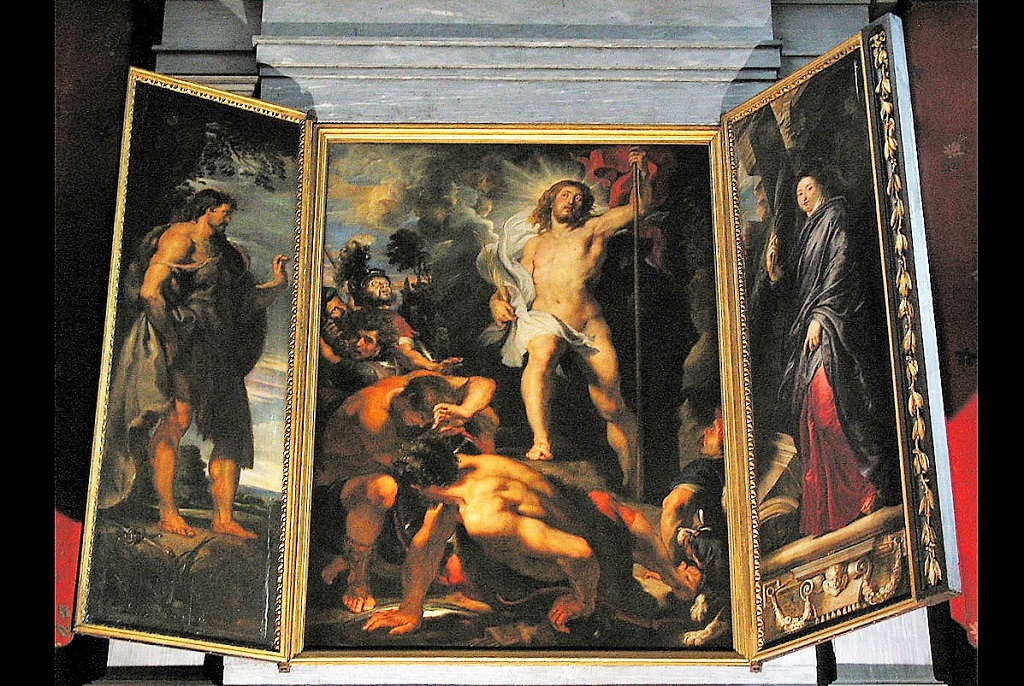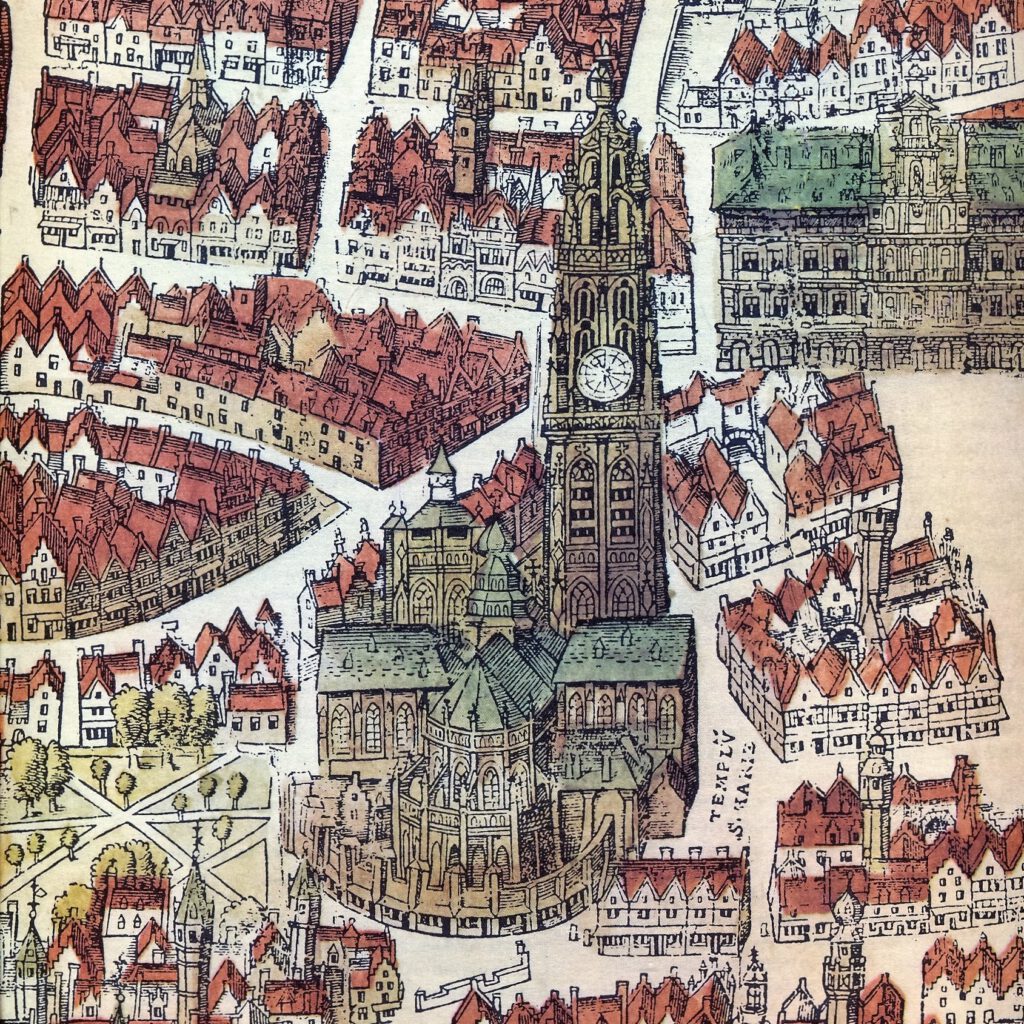The Our Lady’s Cathedral of Antwerp, a revelation.
The Resurrection (Peter Paul Rubens)
Moretus's funeral monument
After the two dramatic scenes of Jesus’s crucifixion in the transepts the same great master of Baroque painting offers us the wonderful scene of Jesus’s resurrectionThis is the core of the Christian faith, namely that Jesus rose from the grave on the third day after his death on the cross and lives on. This is celebrated at Easter. in the ambulatoryProcessional way around the chancel, to which choir chapels and radiating chapels, if any, give way.. This is the central panel of the 1612 funeral monument for Jan Moerentorf (
1610) and his wife Martina Plantin (
1616). The man, who is better known by his Latin name Johannes Moretus, was Christophe Plantin’s son in law and succeeded him as a business manager of the world famous Antwerp printing shop. In 1794 the central panel was taken to Paris as war booty. Fortunately after Napoleon’s defeat it could come back to Antwerp and a few months later, in 1816, it was again destined for the cathedralThe main church of a diocese, where the bishop’s seat is.. A couple of years later, the Moretus family had the funeral monument partly reconstructed, with a marble memorial slab and a crowning with some angels (Jan-Frans van Geel), who show the medallion portrait of Johannes Moretus (Willem-Jacob Herreyns after the original painting by Rubens, which got lost in the course of time). So now the triptych is in a less eye-catching spot, in the present Chapel
A small church that is not a parish church. It may be part of a larger entity such as a hospital, school, or an alms-house, or it may stand alone.
An enclosed part of a church with its own altar.
of Our Lady of Peace, but still close to its original position in the ambulatory, where the married couple were buried.
The theme of Jesus’s resurrection, the core of Christian faith, is directly connected with the function of this work of art. As it is a memorial for deceased persons it reminds us of God’s eternal love being irrepressible and finally overcoming death. Someone who, as an important business manager, is involved in earthly things but not engrossed in them, has an eye for such far-reaching perspective and so had Jan Moretus.
Both external wings each depict a leaf of a double door with an angel in front of it, on the verge of stylishly opening one door of the tomb, simultaneously with his colleague.

Once the wings have been opened Jesus triumphantly appears from the dark rock-cut tomb, irradiated by dazzling light. Jesus’s robust figure, his upward movement and his attributes, the palm He is holding and the banner on which He leans, emphasize his triumph over death. The light radiating from the resurrected Jesus blinds the confounded soldiers in this early hour of the day. Each of them starts back in his proper way: one goes pale and petrifies with agony (after Mth. 28:4), the other one flees in a panic, still someone else protects himself from the bright light, whereas the man in the front, who has fallen over backwards, is crawling away – in a daring perspectival shortening. In the corner bottom right a last witness is sitting dumbfounded watching this miracle.
On the interior wings the respective patron saints of the married couple turn towards the central panel. On the left wing is SaintThis is a title that the Church bestows on a deceased person who has lived a particularly righteous and faithful life. In the Roman Catholic and Orthodox Church, saints may be venerated (not worshipped). Several saints are also martyrs. John the Baptist, in a coarse frock with the sword by which he was beheaded on the ground. On the right wing Saint Martina is holding the palm of martyrdom. She was tortured to death because she had refused to make offerings to a pagan idol. To illustrate the eventual victory of Christianity the temple of Apollo behind her collapses. Martina Plantin is to be seen a second time in this church, namely portrayed as a child on the picture Jacobus De Backer painted in 1591 for the funeral monument of her parents, Christophe Plantin and Jeanne Rivière.
Rubens borrowed the theme of two angels opening the leaves of a double door behind them from an antique tomb altarThe altar is the central piece of furniture used in the Eucharist. Originally, an altar used to be a sacrificial table. This fits in with the theological view that Jesus sacrificed himself, through his death on the cross, to redeem mankind, as symbolically depicted in the painting “The Adoration of the Lamb” by the Van Eyck brothers. In modern times the altar is often described as “the table of the Lord”. Here the altar refers to the table at which Jesus and his disciples were seated at the institution of the Eucharist during the Last Supper. Just as Jesus and his disciples did then, the priest and the faithful gather around this table with bread and wine. that he drew in Rome in the collection Mattei (now the Vatican). After all the two winged victories guarding the door of Hades could easily be associated with the two ‘angels’ who, according to Saint Luke’s gospelOne of the four books of the Bible that focus on Jesus’s actions and sayings, his death and resurrection. The four evangelists are Matthew, Mark, Luke, and John. ‘Gospel’ is the Old English translation of the Greek evangeleon, which literally means ‘Good News’. This term refers to the core message of these books., watched over the tomb of Christ (Lk. 24:4). Maybe the idea for this was inspired by a sensational discovery on the premises of Saint Michael’s AbbeyA set of buildings used by monks or nuns. Only Cistercians, Benedictines, Norbertines and Trappists have abbeys. An abbey strives to be self-sufficient., Rubens’s close neighbour, in 1608 or 1610. The findings included a Roman funeral urn in the form of an antique burial chapel with a double door: no doubt this was all the talk in humanist circles.
So as to ‘overshadow’ the palette of this funeral triptych as little as possible with coloured light, at the end of the 19th century stained glass windows in grisaille were preferred for this chapel.


